|
|
Upon first glancing at miriam cooke’s Tribal Modern, I immediately noticed the cover image and began to guess why cooke may have chosen it. The photograph shows traditionally dressed men riding camels on a paved road, framed by towering skyscrapers in the background. This image, as well as the book’s title printed across its center both allude to a paradoxical state of being- the old and the new mingling in unfamiliar ways. Indeed, this irony is at the center of cooke’s book and argument. She seeks to dissect and understand the intersection and space between the traditional, or “tribal,” heritage of the Arab Gulf and the region’s recent shift to the hypermodern, beginning the book with two of her own radically different experiences in Dubai in 1973 and 2008. cooke analyzes the juxtaposition of the tribal and modern and challenges the perspective that these two forms of existence must be at odds with one another and discusses the ways that the idea of the tribe continues to manifest in society as well as the ways that its presentation continuously changes. While her subject matter is academic and in nature and is at risk of becoming tedious for the reader, cooke presents her argument in an accessible manner. Each chapter builds upon the previous one and cooke ties these chapters and ideas together using the analogy of barzakh, an untranslatable term whose meaning she applies to the adjacent “tribal” and “modern” throughout the book. Finally, cooke strengthens her argument and ties together the academic with the tangible world by using examples of poetry, literature, and art to reveal the ways that those who live and experience the tribal modern understand its implications. These mechanisms serve to make Tribal Modern clear and approachable for many readers.
cooke’s central claim revolves around the intertwined nature of tribal roots in the Arab Gulf and the appearance of a hypermodern present. She argues that these two, at least in this region specifically, are necessary for the existence of each other, writing that “the tribal as it appears in the Arab Gulf today is integral to the modern; it constitutes a crucial element in the Gulf’s modernity” (9). For example, in the book’s later chapters cooke discusses the necessity of “branding” countries in the Gulf using distorted historical and tribal elements to cater to a modern touristic audience and create clear distinctions among different countries, a process which shifts understanding of these traditions (i.e. camel racing). Thus, in the Gulf, she argues, the tribal and the modern continuously shape and influence each other, both connected and disconnected. She frames this argument with an analogy, using the Qur’anic term “barzakh.” According to cooke, barzakh is untranslatable into English and “denot[es] undiluted convergence” and “depicts simultaneous mixing and separation in two dimensions: metaphysical and physical” (10). She explains that barzakh is mentioned three times in the Qur’an: once to denote the time between death and rising, and twice referring to the space between a sweet sea and a salty sea, the place by which the seas are both mixed and separated (71). In cooke’s perspective, this word mirrors the situation of the tribal and modern. I appreciated her use of this term, in particular because of its untranslatability. Although I could not fully grasp its meaning, by learning this word I had gained a term for a concept I had before been unable to sum up into a single word. Tribal Modern seems to be at least in part directed towards Westerners like myself who speak English and are somewhat unfamiliar with the historical context of the Arab Gulf. The use of an untranslatable word reflects the idea that many outside observers may not initially understand that the tribal and the modern are not at odds with one another and instead work and flow together cooperatively. Rather, this new word excellently explains the phenomenon at work and expresses the novelty of this idea to the outside observer. Thus, the use of this analogy throughout the book links each of cooke’s examples to one another and creates easily understood continuity.
In addition, cooke strengthens her argument and engages the reader by citing relevant art, poetry, and literature, rather than using purely scholarly sources. She acknowledges this in her conclusion and says that she has chosen these sources because “creative writers and artists are always ahead of trends, able to see beyond the confusion reigning during times of change” (164). Beyond this, I found these poems other pieces valuable to see the perspectives of those who lived in the Arab Gulf during such times of change, and to see how those various perspectives were similar and different from one another. cooke’s descriptions of the responses to a class survey about tribe affiliation and her description of the Million’s Poet contest were particularly valuable in showing the evolving viewpoints of those living within the barzakh of the tribal modern. These examples help the reader to conceptualize the ways that this confusing juxtaposition affects modern lives and understanding of the past.
As I have not studied in depth the topics addressed in Tribal Modern, nor have I traveled to the Arab Gulf myself, I am not able to fully critique cooke’s argument or information presented. However, I found the book to be interesting and informative. I would recommend Tribal Modern to any reader looking to learn more about the Arab Gulf region or any of the broad historical processes addressed in the book, as cooke’s analysis is accessible and useful for many readers. Her analogies and use of primary source perspectives serve to explain the confusing proximity of the tribal and modern.
I had never realized just how much I took for granted my home shower before spending six weeks in Morocco. Every morning that I lived in Rabat, I would pull a large yellow bucket into the bathroom and place it underneath the bathtub faucet, carefully watching as scalding water poured into the makeshift cistern. Once the water was about half way up, I turned off the heater, letting the cold gush into the steaming pail. I dove my hand into the water and stirred it around, imagining the perfect bathing temperature. Once the water was mixed to my liking, I was ready for a relaxing and refreshing bucket shower. It comes as no surprise that the amalgamation of hot and cold could fabricate a tepid bath in the Moroccan capital; but, the concept is almost like an alchemy of sorts. Hot and cold are but one of the seeming opposites encountered in everyday life, so one can only imagine the combinations possible. Consider “tribal” and “modern,” two words historically divided by what some might think of as ignorance and progress. In her novel Tribal Modern, Miriam Cooke explores the chemistry of these two forces in the Gulf nations of Bahrain, Kuwait, Qatar, and the United Arab Emirates. Cooke performs a delicate excavation of Gulf society that works layer by layer to uncover the treasure-like truth hidden beneath the sand, but leaves the reader feeling as if they dug one hole too many to find it.
In preparing the water for my bath, there is no way for me to tell which water was originally cold and which was hot. The water has a certain sameness to it, indistinguishable through and through. However, Cooke affirms that the “tribal” and the “modern” can not only coexist, but in fact can do so without one usurping the other. She opposes the contemporary view that the two ideas are in some kind of perpetual conflict or that they represent a growing cognitive dissonance in these states where one can watch camels walk stately in front of towering modern skyscrapers. The synchronicity of the tribal and the modern is best understood by the Quranic concept of barzakh. Cooke explains this as the “simultaneous mixing and separation” in both the physical and metaphysical worlds (10). She describes the interaction of tribal and modern aspects in the creation of a “national brand” in which these values in seeming contradiction become spectacles with which the emerging nations carve their own identities.
Cooke’s argument follows a very natural progression, leading her reader through different stages of development that result in the invention of these national brands. She begins by discussing the historical background of the Gulf states and how they impact the most fundamental conceptions of identity. She notes how a rich and ancient heritage tracing back to interactions with Iran and India is swept under the rug in favor of a homogenous history that accentuates the British and Americans as the first foreigners. She argues that in these countries, lineage is a source of entitlement and citizenship which helps to conceptualize a more contemporary notion of tribalism. With this first layer uncovered, she plunges deeper into tribal institutions. Her recount of the transformation of tribe into race into class represents some of the most important interactions and interdependence between the tribal and the modern. This relationship is key in the formation of “brands” in throughout the Gulf region. These brands are reaffirmed through the use of national museums and symbolic architecture which bolster and export the culture. Furthermore, the editing of traditions like sport and, as discussed earlier, history itself helps to redefine a modern Gulf state that has unbridled heritage and ties to the past. Cooke’s argument in the creation of national brands and their maintenance is lucid and precise while preserving a level of interest and forward momentum. The intellectualization of the barzakh relationship between the tribal and the modern provides an alternative and substantiated analysis of the modern Gulf states that is cogent and rewarding for its reader.
Cooke, however, also considers the impact of women and sexuality on the conception of the tribal modern state. She examines the role of women in navigating the barzakh using tropes of misogyny from authors like Hissa Halal who criticize the treatment of women in these cultures. Her introduction of fringe groups like the “boyat” considers the effects of gender nonconformity on the creation of these national brands, as well. While her discussion of the “gendering” of the tribal modern in the Gulf states is interesting and informative, it remains impertinent to the argument outlined at the beginning of the book. The discussion of gender provides a new perspective on the issue, but it remains an entirely separate influence from solely the tribal and the modern on which Cooke intends to focus. Although this section offers new insight, it warrants its own separate discussion rather than a half-formed appendage to a full-bodied discourse.
I would like to think that after six weeks in Morocco, I had crafted a methodology for the perfect bucket shower— four-fifths hot and the rest icy cold. Miriam Cooke seemed to take the same approach in writing her novel Tribal Modern. The book is an immensely fascinating read. It satisfies a certain itch to understand the rapidly modernizing nations of the Arabian Gulf and the region’s seemingly glaring contradiction. The lens of barzakh allows for a prudently organized analysis of the processes that brought states like the United Arab Emirates to where they are today. The adroit use of written word to express well-defined arguments makes Tribal Modern an enjoyable spotlight on a part of the world shrouded in mystery. For anyone interested in getting their hands dirty in digging deep into the history of the Gulf, this book gives you the perfect opportunity to do so. However, like the water prepared for my shower, Cooke’s work contains moments that are both hot and cold, as the sections like those of gendering in the tribal modern fall flat. A book for any armchair historian, student, or scholar alike, Cooke’s Tribal Modern has a little bit of barzakh for everyone to explore.
At first glance, the title of miriam cooke’s 2014 book Tribal Modern seems to be an oxymoron. “Tribal” invokes images of the archaic, the traditional, and the rudimentary, while “modern” is associated with the new, the dynamic, and the technological. The driving argument of cooke’s book, however, is that the two are not, in fact, mutually exclusive. In the Arab Gulf, she explains, tribal bloodlines, hierarchies, and traditions are being upheld alongside technological and cultural advances. Through the metaphor of the barzakh, and the inclusion of artwork from the region, cooke thoroughly covers several spheres where the tribal coexists with the modern and dispels the myth that such cohesion is impossible.
The term barzakh comes “from the Qur’an where it depicts simultaneous mixing and separation in two dimensions: metaphysical and physical. The undiluted convergences between this life and the hereafter and between salt and sweet water…” (10) cooke parallels the presence of the tribal and the modern in the Arab Gulf to the Qur’anic barzakh: a space where the two can mix without either being lost. By presenting this metaphor early on, cooke helps the reader understand where the rest of her book is going, and it provides an excellent visual to accompany her argument as she explains barzakh architecture, dress, work, familial relations, and more.
cooke further strengthens her argument by filling each chapter of her book with artwork produced by local artists. Because cooke herself is not native to the Gulf, rather, an outside researcher, the inclusion of poetry, photography, and fine arts by Gulf artists allows her readers to gain the perspectives of those who live in the barzakh. Some of this artwork rejects the modern and encourages the tribal, such as these poetic words by Kuwaiti writer Saud Al Sabah:
“My country
Put down the currencies bulletin, leave the stock exchange
And join the Arab forces” (115)
Written in response to obsessions with wealth and oil, Al Sabah clearly desires a return to more traditional sources of livelihood and a commitment to intra-Arab relations and culture. Conversely, other writers have written disparagingly about more tribal aspects of Gulf culture. Depictions of pearl diving, for instance, have been sanitized and romanticized for media in modern times. Artists and poets like Shurooq Amin, however, are working to ensure that the true narrative of pearl diving is kept alive: a dangerous, often life-threatening occupation undertaken by those who had no other means of livelihood in the pre-oil era. Here is an excerpt from Amin’s heartbreaking poem about pearl diving:
“…tell me, son,
as you lie
heartbeat-less
on my deck
how to spare
your mother
these tidings.” (111)
Including these artistic perspectives is what pushes cooke’s work beyond a simple academic research project. It allows her book to encompass numerous perspectives on the struggle to preserve and cherish the tribal while constantly pursuing the modern. From the observance of Gulf artwork over time the reader can infer that the tribal modern barzakh is not static; it ebbs and flows and grows and adapts as circumstances and norms change not only in the Arab world but in the global context. It includes many different voices and opinions as tribal customs dictate life in the modern world.
Perhaps my one critique of Tribal Modern is the lack of perspectives given by those who are excluded from the tribal lifestyle of the Gulf. In the first chapter, cooke discusses how migrant workers from Iran, Pakistan, India, and other parts of Asia came to the Gulf for work but found themselves trapped: unable to obtain citizenship in the Gulf because of tribal priorities, but also unable to afford to return to their homelands. As the book progressed, I felt that I hadn’t learned much about these dispossessed peoples. I believe that their voices, stories, and artwork would have been a welcome addition to the barzakh narrative.
Overall I enjoyed reading cooke’s book. I had no idea that Gulf tribal connections and culture had persevered in the face of luxury resorts and sprawling shopping malls, and I found the format of Tribal Modern accessible. Perhaps this is because I enjoy artwork, and this book relies significantly on artwork to make its argument. I would recommend this book to anyone who is curious about how the tribal and the modern can not only coexist but thrive off of one another.
Ahmed Salat
Miriam Cooke’s Tribal Modern: Branding new nations in the Arab Gulf gives a detailed account of the development of the Gulf countries over the years and how the concepts of tribe and modernity interrelate and shape the social, economic and political aspects of these countries. As she follows history to explain how these countries have evolved from nomads in the Sahara and pearl collectors, to building the tallest and fanciest buildings in the world, Cooke sheds light on the idea of tribe and how it has influenced citizenship, promoted racism against foreigners- mostly Asians who came to these countries seeking jobs- and redefined social classes. She writes, “In today’s Gulf, tribe becomes race for exclusive citizenship; race becomes class for a larger share of the national wealth; wealth subsidizes the production of an essentialized tribal culture, a national culture appropriate for insertion into the twenty-first-century world where these Gulf states wish to play a major role.” (p 63) This shows how important of a determinant the tribe is and a source of exclusivity for certain people, mostly foreign workers.
While reading Cooke’s book, it was interesting to see how deeply rooted the institution of tribe has been and still is in these countries. For example, intermarriages have been used to keep purity within the tribe, as Cooke notices when she talks to the director of the Shafallah Medical Genetics in Doha, who tells her that in Qatar, 30% of marriages are between first cousins thus producing an “isolate society.” (p 47) While some people might think that the combination of the institutions of tribe and modernity is “a loss of tradition and a failure to modernize”, Cooke disagrees and says that the idea of tribe has enabled hypermodernity. The tribe gives these people a sense of belonging to a given nation thus promoting nationality.
I found interesting Cooke’s use of barzakh to explain the separation yet the interconnection of the tribal and modern. Her use of the Quranic verses to support her explanation of barzakh even makes it more captivating. To explain how this space (“barzakh”) between tribal and modern influenced each each aspect, she writes, “In the fifty-year barzakh linking and separating the pre-oil sheikhdoms and today’s nation-states, each is shaping the other in a dynamic, cultural-political field in which apparently contradictory states remain in balance, the tribal does not compromise with the modern, nor does the modern erase the tribal.” (p 75) The tribal modern is the barzakh which connects and disconnects the different identities of the nations.
Cooke’s use of personal anecdotes- from her couple visits to the Gulf both as early as 1973 when a country like Dubai was just “ a dusty town of one- and two-story mud buildings” (p 2) and as late as 2008 when Dubai had “a population that has increased twentyfold and skyscrapers blanketing miles upon miles of what used to be desert” (p 4)- give the novel authenticity while at the same time not to losing focus on the more important history of the development of these Gulf nations!
Cooke is such a great author and her books never disappoint. I read and loved Dancing in Damascus last semester and was excited to read Tribal Modern too and as I expected, it turned out to be a great read.
Tribal Modern is a concise yet nuanced description of the Arab Gulf’s pre-modern history and its path to current modernity. Miriam Cooke masterfully introduces and creates the juxtaposing (to the West) idea of a tribal and modern society coexisting in the same time and space, mixing and simultaneously, not mixing. Through Cooke’s inclusion of anecdotal evidence combined with the inclusion of expert opinions, the reader manages to gain a comprehensive understanding of the subject at hand.
Cooke explains that through adaptations of a traditional, often make-believe past, the post-oil Gulf states have created a unique brand for themselves, one that suggests luxury while satisfying the Western desire of orientalism. In her book, Cooke argues that for the Gulf states, “tribal” has become synonymous with “authentic”: therefore, any traces of foreign influence and cultural appropriation from an “other” must be erased. Cooke writes, “the fantasy of first exposure to outsiders must be maintained” (Cooke 28). This has created an intolerance for foreigners and outsiders to appropriate the Arab Gulf’s culture.
Furthermore, this adaptation of fake traditions serves to establish the privilege of the elite tribal minority by asserting them unique right to citizenship and exclusive entitlement to national wealth. Cooke points out that while many would believe that the grasp of tradition would decrease as a country’s income increased, the opposite has happened in the Gulf states. Because these countries are now composed of a foreign, second-class citizen majority, the grasp of untarnished tradition is a clear sign of elite tribal lineage.
The legitimacy of the systematic way of appointing privilege and national wealth through tribal lineage is evident in Cooke’s interactions with Qatari university students. When surveyed about how much tribe factors into a potential marriage partner, many indicated that tribe held some importance when looking at marriage compatibility (Cooke 42). The importance of this ethnographic effort cannot be underestimated—Cooke took what she found to be a peculiar aspect of Gulf tradition and expanded formal research effort that shed light into it.
Interestingly, those who are familiar with Modernization Theory will constantly think about it while reading this book. Modernization Theory explains the modernization of the nation-state as it being a linear path, beginning with a “third-world” country, and the end product being essentially, a copy of the US, in all its democratic and capitalistic ways. Cooke’s argument that tribal and modern aspects aren’t contradictory, and that they complement each other, serves to disprove this neocolonialist way of thinking. There should not be one trajectory to modernization, and the final product doesn’t have to be an exact copy of the US.
Furthermore, by whose standards is the intellectual community measuring “modernization”? The system used by one country should not be imposed across the globe, because this system does not account for nuances integral to different societies. The West, by placing itself on a pedestal, has assumed that there is nothing it can learn from countries that do not share its ideologies. However, even beside that point, the notion of tribal wear contradicting modernity sounds absurd from a practical stance. For example, jeans as casual wear are impractical. They are thick and heavy, making them harder to wash and dry than an ‘abaya. So then the question is: Why is the former celebrated as an indicator of modernity and the latter considered a clinging tribal relic by Western standards? Through Tribal Modern, Cooke dispels the idea of this divide, and with that, the assumption that they are mutually exclusive.
The beauty of this book is that it is appropriate for both the academic community, and for the average reader. Anyone with even the slightest hint of interest in the Middle East, or history in general will enjoy. Its anecdotal evidence, combined with concise points, make for an enjoyable short, relevant, and informational read. Seeing the Arab Gulf through Cooke’s eyes is a one of the least problematic ways to introduce this area of the world. There is a stark difference between culture in the West, and culture in the Middle East, regardless of how much of it has been fabricated to create a brand. With the current rise in xenophobic tendencies in the Western world, these differences are often left unexplored and frowned upon. This book will be integral in bridging that divide.

Aerial view of Fes, Morocco. https://commons.wikimedia.org/wiki/File:Fes_(5364182941).jpg

Aerial view of Rabat. https://www.airpano.com/360Degree-VirtualTour.php?3D=Rabat-Morocco
Disregarding the one Moroccan who claimed he was surprised that I wasn’t Moroccan and even said that “[I] look Moroccan,” I’m confident that everyone in Morocco sees me as a foreigner – someone who is simply not native to Morocco, no xenophobic implications attached (interestingly I think I’m frequently assumed to be European first; while I don’t have a “reason” why, my guess is that it’s largely based on an availability heuristic because Morocco has far more tourism from Europe than from the US).
No matter where you are in the world, you’re treated differently dependent on how you’re perceived by the population; it’s simply human nature for us to perceive distinctions between other human beings, and these distinctions often lead to variation in human interactions. Perception of foreignness, or rather the perceived degree of human separation between yourself and someone else, is perhaps the single most important factor that contributes to distinctions in human interactions. Though I’ve only been in Rabat for a week, I can already tell that the city has a weaker perception of foreignness than Fes, and this results in a big difference between my human experience in these two cities.
In Fes, even as tourism continues to grow, foreigners are anomalies. Ville Nouvelle (the French section of a Moroccan city, specifically the one from Fes in this case), despite being built by the French to accommodate its own nationals in Fes, still feels like a place where foreigners really aren’t meant to be. And this lack of belonging is much stronger in the old medina (Fes el Bali). A way of life that has been sustained for 1,000+ years is by no means accommodating to people for whom the city was never built. Meanwhile, Rabat’s history is rooted in European involvement in Morocco, so Rabat is by nature far more experienced with white people whom are less perceived as foreign in this city. Rabat actually has a pretty old history itself, created by the Almohad Caliphate during the 1100s, but because the city was so much smaller than Fes, it would eventually be defined by its European intervention – unlike Fes where it’s hardly part of the city’s identity. Fes was actually originally intended to be the capital of the French protectorate (as it was the capital for most of Morocco’s history and the current capital at the time of invasion), but because of the city’s strong sense of history and its resentment of the invading European powers, Rabat was chosen instead – the weather was better there, too. Fes held its ground, but Rabat became a byproduct of France and lost much of its strictly Moroccan identity, paving the way for Europeans and other foreigners to feel far less “foreign” today.
As for how life is different based on the perception of foreignness, it mostly boils down to the principle of treating people better if you’re closer to them and more connected to them. Overall, Moroccans are very hospitable and friendly, largely as a result of their collective identity. Foreigners will be able to get a sense of that, but they will never have the same benefits and social capital as Moroccans do when visiting the country. The difference in this treatment is fairly subtle and difficult to elaborate on, but the best example of this phenomenon would be business transactions, specifically taxis and shopping in the souks of the old medina. Regarding taxis, drivers in Fes are very eager to try and make several extra draham (plural of dirham, the currency of Morocco, with one worth approximately $0.11) by charging an upfront fee higher than what taxi users are supposed to be charged based on the distance driven. For example, a metered taxi from my home to my school should have been around 12 draham, but since it was slightly out of the way, drivers in my neighborhood would insist on my roommate and I paying 20 draham to go there or paying 10 draham to go somewhere else that was an 8-minute walk away from school. While the money isn’t much (it does add up over time), I was most bothered by the principle of having to pay a tax of sorts because I wasn’t from Morocco; the attempt to overcharge customers is not something limited to foreigners, but from what I’ve observed, foreigners are way more likely to be exposed to this reality. In regard to the souks of the old medina, whenever asking how expensive something is, it’s almost a guarantee that you’re being charged too much. This is true for foreigners and Moroccans alike, but foreigners are still charged more upfront. And no matter what, foreigners will never be able to achieve the “local price,” settling for what is most likely a good deal but still at least somewhat unfair. Rabat, on the other hand, seems to have a much weaker perception of foreignness within the business realm. I cannot speak from personal experience in this department because I live walking distance from my school now, so I have no need for taxis, and I haven’t had a chance to shop in the old medina yet. However, at least concerning taxis, I’ve heard every group member that’s taken taxis in both cities say that taxis are better in Rabat and that none of them have been scammed here. If there’s no “foreign tax” on taxi rides in Rabat, I think it’s safe to assume there is a smaller, if any, foreign tax when shopping in the souks of Rabat’s old city; other reasoning to support this hunch is that – once again – people in Rabat are much more accustomed to Europeans so they are less likely to perceive white people as foreign, and also, because the medina is more spread out than Fes el Bali, the souks are much smaller, and the medina is much more accessible to the European part of the city, the medina has a greater general sense of openness. Regardless of the reason for the difference in treatment, foreigners pay a smaller price for their foreignness than in Fes, but Moroccans themselves have to pay a greater price in the form of culture and identity as a result of its exposure to colonialism and capitalism.
With my understanding of Morocco, I came to believe that Rabat would have virtually no culture; while I was exaggerating, I have been pleasantly surprised with the culture intact regarding Rabat’s medina. But despite this, my general presumption has still shown to be largely correct: the medina of Rabat is smaller than that of Fes in terms of size, culture, population, and history. When France decided to make Rabat the new capital, there was simply less culture for the city to hold onto. Even though the medina was preserved, the Ville Nouvelle clearly became the most important part of the city because it has been home to essentially all of the city’s governmental operations and modern business enterprise within the past 100 years; prior to the creation of the French section of the city, the French census placed Rabat’s population at around 25,000 in 1912, while the whole city’s population is almost 600,000 people today. During the French protectorate, foreign nationals constituted around 30% of the city’s population; now, that number is much less since there are less than 100,000 foreign residents in all of Morocco. While colonialism has ended, the central force holding onto the Ville Nouvelle as the center of Rabat is arguably capitalism. When the French protectorate ended, the Alaouite dynasty decided that Rabat would remain the capital and the royal family, whose palace was in the European section of the city, would stay there. The family could have returned to the historical capital or any other city, but it stayed in Rabat; that suggests the royal family found French development appealing and/or desirable, and that development is inseparable from capitalism. As Mohamed VI continues to modernize both Rabat and even his own institution of monarchy, one thing remains clear: capitalism is the strongest force driving Morocco today, and the economic theory certainly isn’t foreign to Europeans or Americans. France may have been the initial cause for Rabat’s weaker perception of foreignness, but as the city modernizes – it eventually plans to complete the tallest skyscraper and largest opera house in Africa – and attempts to implement itself into both the Western and global world, foreigners will only become less foreign. Fes, too, will become more modern over time as tourism and industry increases, but because Rabat is the capital and center of the king’s plans, it will also be Morocco’s least foreign city for the indefinite future.
Inhaling the mixture of urban air and ocean breeze, the city of Rabat begins to settle within my lungs as the final remnants of Fes gradually become snapshot memories. Upon stepping into the new city and arriving in the center where our classes will be held, neurons began to sizzle, spark, and fire away in pursuit of assessing this change in environment.
Rabat is modern. Familiar. Relief was a foreign feeling, and like the local tap water, my entire being rejected the alien substance until it was coaxed into an agreement of overall accpetance. Rabat was so similar to home that I’m positive I could search my home address and it would be a ten-minute car ride away. In fact, I can hear the echoes of my mother’s voice laced with the beginnings of a lecture – confronting my laziness 90% of the time – and nudging at the edge of my long since busted eardrums. Although feelings of familiarity and relief are not arguably unsatisfactory in nature, Rabat invokes my existing memories, feelings, and experiences not unique to this city. The reality is that Rabat does not incite any particular feelings, and in my opinion, builds its visual impact and reactions from previously formed sentiments the general urban setting evokes.
 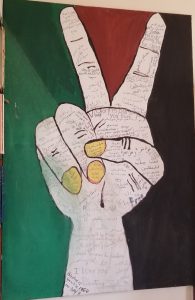
Fes, in comparison, was a cyclone of emotions spiraling near exhaustion, confusion, occasional fits of anger, and perpetual weariness over the unpredictable circumstances of each lively day. If Fes were a chip flavor, it would be spicy mystery-meat tajine with a ranking of eleven-out-of-ten burnt tongues**. Despite emerging from the city of Fez nearly traumatized – in a good way? Still questionable – these experiences and emotions were something entirely outside my sense of comfort. Replicating these encounters is near impossible, and nowhere will I ever see the hidden yet dazzling riads, the equilibrium among old and young alike in the same social spaces, the lively night scenes overflowing with mothers and their playful children into the late hours. Fez has ingraved its distinct atmosphere and immediately visible culture at the forefront of my study abroad experience in Morocco.
**No chip reviewers were harmed in this theoretical process (to our knowledge).
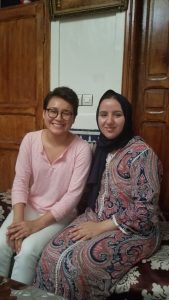 My Fez host mother and I
Regardless of being biased towards the anomaly termed Fes, this comparison doesn’t condone Rabat as cultureless or substantially lacking in any area. Rather, I want to emphasize that the urban setting and (seemingly) higher standard of living within Rabat signifies development with potential for progress. Additionally, with an increasing mobility of individuals upon a global level, large cities share characteristics that provoke recognition and familiarity that might comfort migrants forced to move thousands of miles away from home for varying reasons. Simply because an object, location, or local culture may not be perceived as unique does not alone give substantial reason to regard it as unable to positively impact local individuals.
For the last three weeks, we have lived in the city of Fez, which is known as the religious capital of Morocco. This week was the first where we moved into the city of Rabat, a coastal Moroccan city that is its political capital. The cities, while both emphasizing Moroccan culture, express extremely different cultures that ensure that you have completely different experiences living in one compared to the other.
What really caught my eye about the difference between Fez and Rabat is the difference in modernity. As the religious capital of Morocco, Fez has a spiritual, almost mystic feel to it. Especially in and around the old Medina, every street almost yells at you to take in its rich history and culture. Fez’s old Medina has remained largely untouched, with homes, shops, and mosques seamlessly blended together in the traditional Moroccan architectural layout. Every day, five times a day, the Muslim call to prayer echoes through the streets of Fez, as hundreds of mosques call their citizens to their enclaves.
In Rabat, however, its history is much different. As the political capital of Morocco, its history is laced with European colonization, specifically French influence. Rabat was chosen as the French Protectorate’s capital in 1912, and was built to be the “Washington D.C.” of Morocco. It was built to be a modern city, appealing to the French administrators while also showcasing traces of Moroccan culture. Nowadays, Rabat’s modernity is even more emphasized due to the Moroccan government continuing to construct modern administrative buildings and government centers.
One thing that immediately caught my eye was the amount of constant construction that is happening on a daily basis in Rabat. On my fifteen-minute taxi-ride to school every day, we are surrounded by different building projects. At our host family’s house, we even overlook a large construction site, with sounds of constant building filtering into our room. This is a very different way of living than in Fez. Fez’s main attraction – the old Medina- is largely stagnant, with little construction going on and little-to-none major governmental projects. While this is not a large difference between the two cities, it highlights a major one. Rabat has had the benefit of experiencing riches from both the French Protectorate and the Moroccan government after it. Rabat has constantly been a place for rich Moroccans and Europeans alike to travel to/live in, helping it have enough resources to improve its infrastructure and way of living. Sadly, Fez has not been able to experience these modernizations. Thus, while Fez suffers from outdated infrastructure and rundown houses, Rabat seems to be improving its city with each passing day. While Fez’s historical sites are what make it so great, it is painful to see that it is unable to benefit from the same restructuring and rebuilding that Rabat undergoes.
Overall, I prefer Rabat. It is a much easier city to assimilate to than the more cultural, local experience of Fez. However, Rabat lacks the spirituality and wonder of Fez that made me really feel like I was in a whole new world. With two weeks left in Rabat, I hope I can find and experience the landmarks of Rabat that might offer the same sense of wonder that Fez’s ancient city showcases.

This first picture shows the Rabat skyline, showing how spread out the city is.

This second is taken in the heart of the Old Medina in Fez, it gives you an idea of how clustered and crowded the Medina is.
This time a week ago, while writing my third summer blogpost, I was hit by a strong feeling. A feeling which I couldn’t really decide whether it was one of sadness or happiness. It hit me that that was the last night I was going to spend with my host family at fez- even possibly the last time I’d ever be at Fez. It was a feeling of sadness. Yet I was excited. Excited because I would be spending the next three weeks at Rabat and would visit a different city each weekend: Casablanca, Marrakech and Tangier respectively. And off we went the following day. Goodbye Fez!
Like I mentioned in my earlier posts, a lot of proper planning has been put into designing Moroccan cities. Besides the unique architecture and planning each city has (and of course different colors of their Taxis- for example Fez has red, Rabat has blue and Meknes has light blue), each is unique for a particular crucial activity. Fez is the Moroccan religious center while Rabat is the administrative/political center; Casablanca is the business center while Marrakech and Tangier are more touristy!
Fun Fact: This year’s Super Cup Final will be held in Tangier, roughly two weeks from now, and will involve La Liga giants Barcelona and Sevilla!
I have been in Rabat for almost a week now and while there might be quite a number of things it has in common with Fez, (we still eat bread with everything- I’m not complaining, it’s just fascinating) there’s a lot more difference. As the political hub of the country, this is where most administrative offices are and most of the crucial decisions are made. While at Fez, we mostly visited religious places such as the big mosque of the University of Al Quaraouiyine – the oldest existing educational institution in the world-, the Ibn Danan synagogue and the Center for Suffism, at Rabat we have only visited administrative centers. We went to the Islamic Educational, Scientific and Cultural Organization (ISESCO) headquarters and learnt a lot about the organization’s plans to promote education, science and culture in the Muslim World.
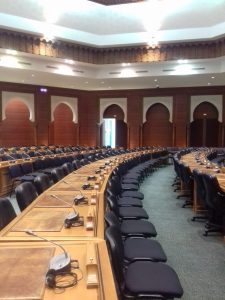 Figure 1 ISESCO’S Conference Room where leaders from the 53 member countries meet to discuss and come up with solutions to issues facing the Muslim World 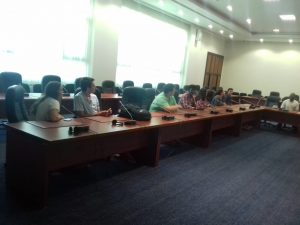 Figure 2 Duke Students following Presentation on the organizations’ work, at the ISESCO Headquarters in Rabat Today, we also had a rare opportunity to visit the Forum for Promoting Peace in Muslim Societies and learnt a lot about their efforts to promote peace through educating people about the Islamic ethics and changing misconceptions that most people have about Islam. The world Islam itself means PEACE and that is what it should be all about.
 Figure 3 Forum for Promoting Peace in Muslim Societies
 Figure 4 Our meeting at the Forum for Promoting Peace in Muslim Societies These two meetings have so far been very helpful in understanding some of the most important issues in the Muslim World and how we can contribute to the needed change in the future. I’m excited for the number of the visits to different offices that are coming up in the next two weeks including a tour of the US embassy in Rabat among others. Also stay tuned to read about the exciting excursions to Marrakech and Tangier the next two weekends!
Appreciation
A very special thanks to everyone who has been following my summer activities! I can’t thank enough those who have been taking their time to read and share their thoughts on my blogs! Thank you and I hope you enjoy all of them
One of the early things I saw as we drove into Rabat was a large black opera house surrounded by several bright yellow cranes. The cranes reminded me of Duke, and this early connection to Duke’s constant construction hinted at the differences I would notice between Fez and my new city. I quickly learned that building isn’t just limited to the outskirts of town. Smaller-scale construction is occurring as well. On the first day of class, I walked out of the Medina right as a large cinderblock clunked to the ground from the adjacent scaffolding. This past Sunday, clanging noises filled our own homestay, since our host family is making a new room on their terrace. Rabat is clearly growing.
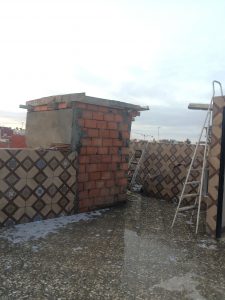 New Room on the Terrace  Construction from the Roof In Tribal Modern, Miriam Cooke argues that traditional and modern do not create a strict dichotomy; instead, they coexist. Though Western scholars depict modern as the antithesis to tradition, Rabat’s construction celebrates the old while it creates something new. The Medina and the Ville Nouvelle overlap in some areas, and Rabat’s sleek tram stops just outside the entrance to the Medina. There are many new building projects – a large business center, the opera house, a mall – that combine Islamic art motifs with the aesthetics of modern architecture. Fez may have culture and preservation, but Rabat is constructing for the future.
 Construction 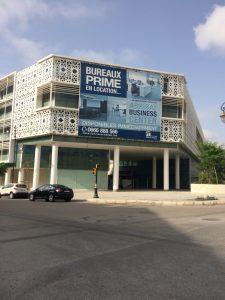 Business Center Across from School While Rabat has more buildings and building sites, many, but not all, are missing the unique vibe of Fez. Rabat’s vibrant murals are the refreshing exceptions to this monotony. Some of these feature faces and more realistic images, as I saw when I was driving back from Casablanca. Others are much more abstract. Morocco’s colorful reputation leaps onto the walls, and it certainly isn’t limited to traditional dyes and handicraft pieces.
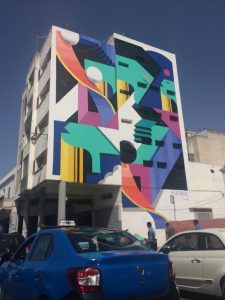 Street Art 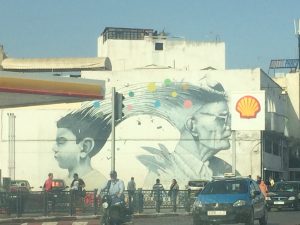 Mural near the Medina In contrast, I only saw one or two small murals while I was in Fez, which retains much of its traditional look. Most of the art was traditional zellij work and limited to one or two sloppily written words. According to David Amster, the director of the American Language Institute in Fez, the Medina receives millions of dollars from initiatives like the Millennium Challenge to maintain its appearance, and there are also laws prohibiting reconstructive work that might damage original woodwork and other artisanal elements of homes in the Medina. Although the Ville Nouvelle has some growth, Fez’s old city is much larger than the Medina in Rabat, and it occupies a much larger space in the city’s day-to-day. In Fez, the Ville Nouvelle has some construction and a modern mall but does not feature new construction on the scale that I have seen in Rabat.
In conclusion, Rabat seems more focused on creating, whereas Fez seems more focused on preserving. Although these seem like general trends to me, they are mostly based on my own observations, which have been biased by the places I have frequented. As I look at the changes in Rabat and the consistent architecture of Fez, I have many questions. Is it possible for a country to truly progress without losing some of its cultural heritage? Can a country improve if it focuses on preserving past cultures? Although Miriam Cooke asserts that this is possible, the differences between Fez and Rabat, including the respective things each city seems to be missing, might indicate there is some value in the binary structure of traditional and modern.
The parlor was set for five with a large silver teapot resting stately on a lacy doily next to five crystal cups and a display of sweet and savory crackers. The late day sun was shining through the open windows above the banquette upholstered in blue, entering freely past the curtains tied to the windowsills. We sat down after climbing three flights of stairs and Karim wiped his moistened brow complaining about the heat. A slight breeze found its way inside uninvited but was quickly welcomed by the party. Malika filled the cups with still-boiling tea, making sure to pour from high above to produce as many bubbles as she could. The glasses were too hot to touch and the tea steamed vigorously out of them. Malika managed to dismiss the heat and took a sip of her scalding tea. “Skhoun,” she laughed, leaning back on the delicate pillows. She placed her cup back onto the table, holding onto the empty top of the glass gingerly with her carefully placed fingertips. I grabbed a cracker to show my interest in the meal, still petrified to attempt in drinking my mint tea. Malika, again, lifted her tea in one hand but grabbed a small paper fan in the other and began to cool herself as she drank her tea. I laughed at the absurdity of drinking hot tea on a hot day, but I mustered the courage to try my own and was pleasantly surprised to find that it wasn’t cloying sweet, the way most Moroccans like it.
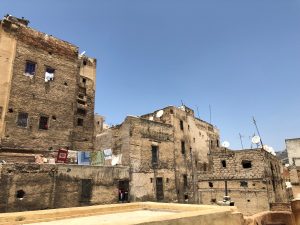 The old Fes Medina Karim interrupted the sounds of cautious slurping in asking me how I liked living in Fes for the past three weeks. “The weather there is so hot!” he told me. “You will find Rabat much better, inshallah.” I cracked a smile and nodded my head in agreement. Almost every day that I was in Fes, the temperature was over ninety degrees Fahrenheit; however, the heat was dry, and generally it was very pleasant under the umbrage of the low hanging orange trees. I admit, walking around the old Medina tended to bring a sweat to my back, especially if I were carrying my books andlaptop for class like some sort of Saharan camel. Even in the early morning, the heat could be insufferable. At night, I slept on top of my covers, pressing my body against the cool bedroom wall. It wasn’t until I was awoken by the call of the muezzin at four o’clock that I finally felt the inside of the dar I was staying in somewhat cold. The Fasi, too, were affected by the sweltering heat. During the day, the most foot traffic found was that of shopkeepers and tourists. It wasn’t until the sun went down that the locals began to come out onto the street and enjoy the “day”. The heat permeated into the facets of everyday life, but I found the same was true of Rabat.
Two hundred kilometers away from the scorched city of Fes, Rabat sits on the Atlantic coast, some twenty degrees cooler in temperature, moistened by the sea air. Karim grabs the remote from the table and turns the TV on to the news channel. Different segments flash on the screen while smaller headlines scroll across the bottom, just like any American news station. In the corner, a display of tomorrow’s weather is shown. Karim shouts, “Twenty-six degrees! Unbearable!” I laugh to myself, remembering how shocked I was upon dismounting the bus after our ride to Rabat from Fes to find the air so cool. I could hardly tell the difference of the outside from the air-conditioned vehicle that I had been trapped in for the past three hours. The days in Rabat stay around a pleasant seventy-five degrees and are certainly more humid than those in Fes. A sea breeze blows gently across the city, refreshing pedestrians and tourists. One afternoon, I decided to explore the area around my homestay and found my way onto a street with many upscale shops. It was the most cars and people I had seen at 3 PM in since being in America. I quickly found that Rabat was much more active during the daytime than Fes. Perhaps it was due to the weather, or perhaps to French colonialism that made the city more diurnal. Rabat gave the impression of being more Western in nature, its buildings newer and sensibilities more European. Where my Moroccan dinners used to be at midnight, I was consistently eating at nine o’clock. But, that makes sense given its colonial past.
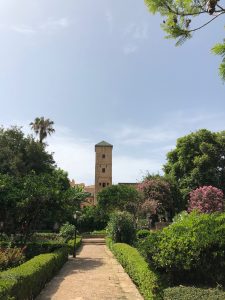 The Andalusian gardens in Rabat  A busy beach in Rabat
Rabat was not always the capital of Morocco. Before the French colonization, the Moroccan capital was in Fes. Today, Fes is still the spiritual and cultural capital of the nation, but Rabat remains the administrative and official political capital. The French chose to move the capital
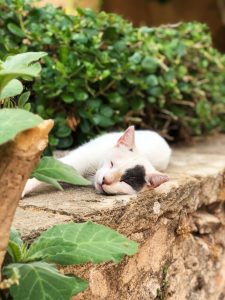 A cat enjoying the weather in Rabat for a variety of reasons. They disliked the location of Fes as it made it hard for French colonists to escape if things turned sour. Furthermore, Rabat came with all the advantages of a coastal city and was close to Casablanca which was correctly predicted to be a commercial mecca for the Western world. Rabat was at the crossroads of both Fes and Marrakesh, as well, granting it a central location to the most important spots in the country. From Rabat, the French could rule effectively and comfortably, especially in the paradisal climate. The two cities paint very different pictures of Morocco. Fes crafts one that is cultural and harkens to its ancient heritage as well as one of blistering heat and late nights. Rabat, however, shows the more commercial and modern side of the country, but still maintains the essential ideas that make Morocco unique.
In Rabat, the people take the weather for granted. They imagine living in the Fes valley with distain and gasp in horror when they hear about our escapade to the Sahara in the hottest month of the year. Accustomed to the temperate, they fear the heat. When my host family asked about my plans this week, I informed them of my intentions to visit Marrakesh on the weekend. And to that they said: “You’ll melt!”
Our first three weeks in Fez have come to a close and our group has moved on to Rabat. These two cities, separated by 200 kilometers, showcase very different aspects of Morocco. Fez is the historical and religious capital, while Rabat is the political capital.
One of the first things I noticed about Rabat, aside from its size, beautiful architecture, and rocky shorelines, was its cemeteries. During our first day in the city, overlooking the ocean from a restaurant near the Rabat Kasbah, we watched the Atlantic waves crash against the rocky shore while hundreds of people milled about on the beach and umbrellas dotted the sand. What I didn’t expect to see were the vast cemeteries framing the edge of the sea, nestled between the beach and the city behind it.
I immediately had a lot of questions. Just a few days prior, Safae, a master’s Student in Fez, had visited our class to discuss her thesis research. Safae explained that she was studying the differences between women’s involvement in Sufism than in other sects of Islam. One lens through which she examined female Sufi leaders’ importance and societal impact was the locations and discourse surrounding their grave sites. For example, she explained that when researching these grave sites, the women’s burial locations were often described in relation to men’s grave sites.
Hearing Safae discuss the social implications of grave sites reminded me of my own experiences and fascination with the history and social situations reflected through cemeteries.
After researching my own family tree for a few years, I’ve used lots of data from cemetery databases, such as Findagrave.com. The site has a huge database of cemeteries, with memorials showing each person buried within the cemetery. Often, the memorial is accompanied by a photo of the headstone, which can be useful to family members and researchers as it may show the birth or death date of the person, or the names of close relatives such as a spouse or child. If the memorial doesn’t happen to have a photo, the researcher can request that a person in the cemetery’s area travel to the cemetery to take a photo and upload it to the site.
I’ve started taking these photographs in my spare time in my hometown of Fredericksburg as well as in Durham and have been surprised by the things I learn and the ways I feel more connected to my community. In Durham, cemeteries often vary in many ways- the size of the headstones, how many graves are marked, the maintenance of plant growth in the area. These factors can provide insights into the history of the cemetery itself, the lives and backgrounds of the people who are buried there, and the social, political, economic, and cultural systems during their lifetimes.
Staring out at the huge cemeteries along the shore, I wanted to know why such large cemeteries were immediately very visible in Rabat, while after spending three weeks in Fez, the only cemetery I had seen was the Jewish cemetery (which took quite a journey to locate). This certainly might have been only coincidence but did get me thinking about the different historical contexts in Fez and Rabat that may have contributed to this difference.
I attempted to do some research on the histories of Rabat’s many cemeteries, but found limited information online, at least in English. While this lack of information was frustrating, it did make me think about why my questions might not be answered by a quick online search, and what other places might hold that knowledge.
After a few days in Rabat, I was able to visit the cemeteries near the ocean. While I didn’t learn much about the history of the cemetery, it was interesting to see many apparent traditions up close. Each grave faced the same direction, as it is customary for the buried person to face Mecca. I was also interested to see that most graves were composed of a back headstone and a rectangular area on the ground, with a middle section full of soil. Some graves had plants growing from these inner sections, and I wasn’t sure of the intentionality or significance of this. I wasn’t able to understand the writing on the headstones with my small knowledge of Arabic, but I hope to return during my time in Rabat to try to translate some of these and to learn more of the cemetery’s history, and well as that of others in Rabat and Fez.
Writing this week’s blog post left me with way more questions than it did answers, but its also encouraged me to be more aware of the histories of the places I visit, do research beyond just a quick google, and to keep wondering about the stories that cemeteries might tell.
 A cemetery in Rabat
|
|






















